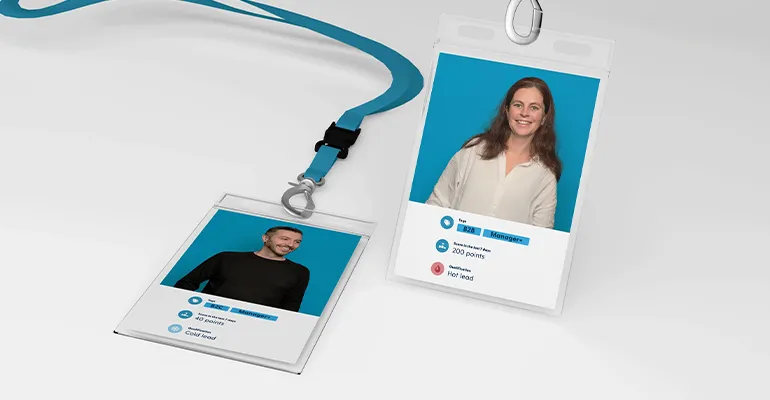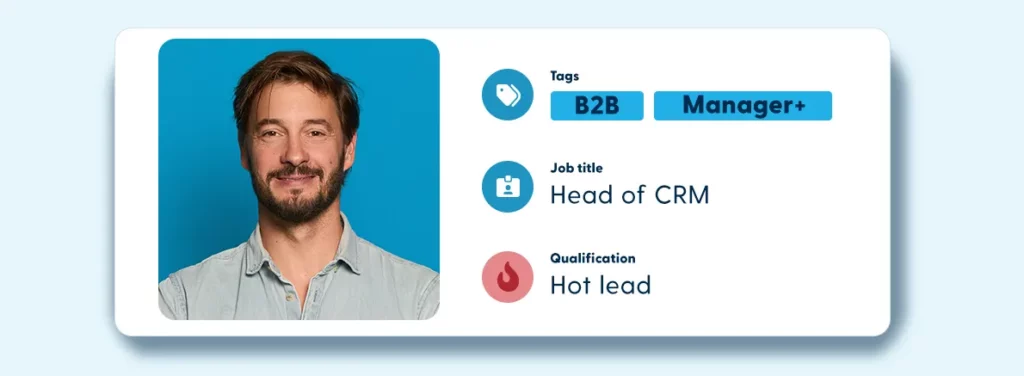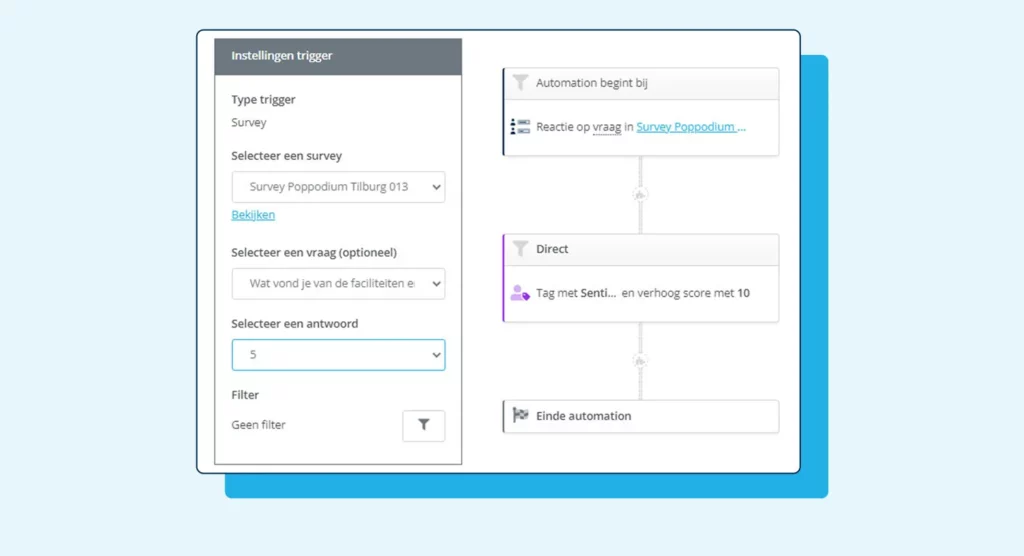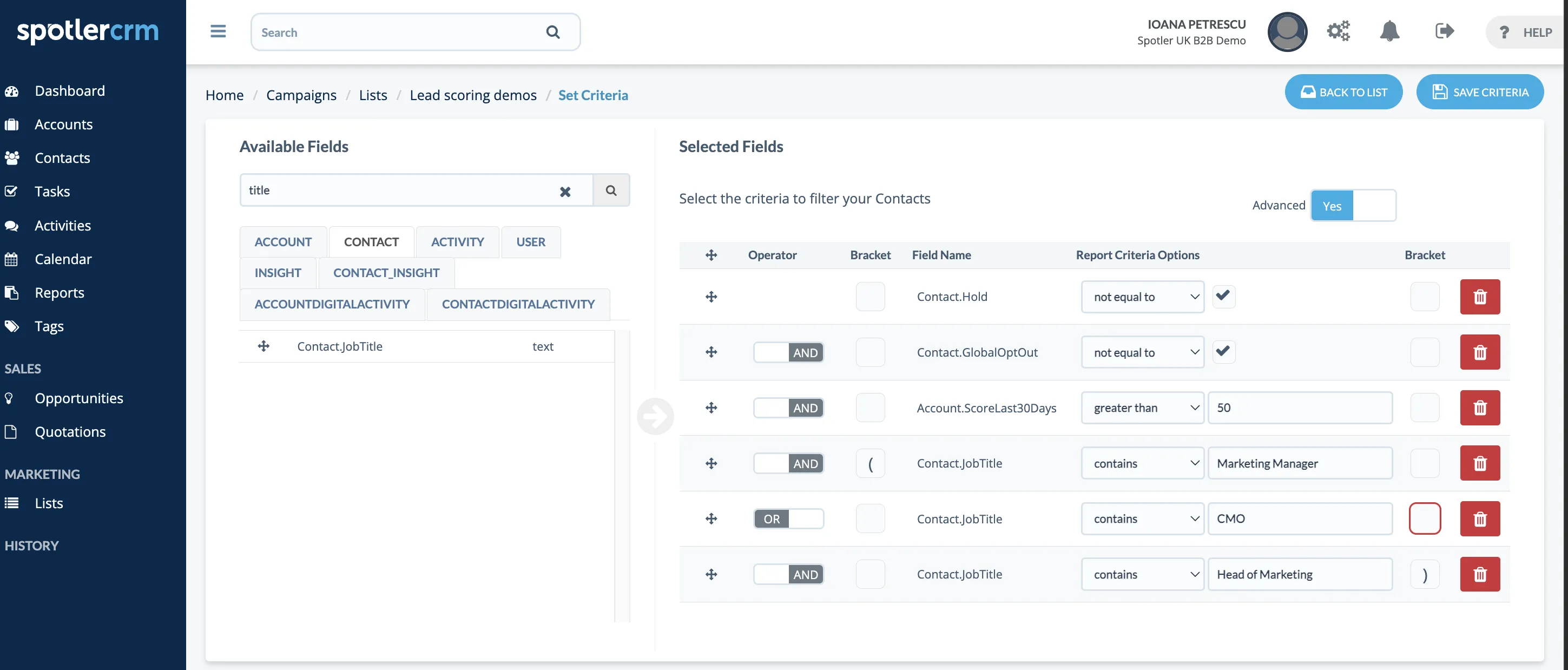
How do you apply tagging and scoring?
Tagging and scoring allow you to mark and qualify the engagement of your contacts. You can then follow up with personalised and segmented actions. This is good for both your engagement and your conversion. Below, we would like to explain what tagging and scoring involve and how you can apply these techniques in Spotler Mail+ and Spotler CRM.
What can you do with tagging and scoring in marketing?
Every sales and marketing employee wants to know which interactions customers and prospects have with his or her organisation. You want to know who fills out which forms, which emails they have interacted with, which website pages have been visited and who, for example, fills out your survey. You can label this behaviour with a tag and qualify it with a score.
Tagging and scoring can help you refine your database. To give you an example of CRM automation:

As soon as a lead fills out an online form, this digital activity is given a score of 10 points. In addition, this activity is added to the B2B tag. If the criteria for leads are met, Sales receives a notification. In this way, Marketing labels the filling out of a form with a tag and a score.
What is tagging?
Tagging as you see in the example above means that you give an action on your website a label. With tags you can more easily create targeted and personalised campaigns. But that’s not all. Many marketers also use tags to create order in the large amount of data they hold. At Spotler we do that too.
For example, we use a tag ‘ Manager+ ’ where we include all job titles with ‘Head of…’ and ‘…Manager’ or ‘CxO’. We place this tag as soon as data comes in, for example via a form in which one of these job titles appears. We also use tags as filters on incoming data. We give the behaviour a score.

What is scoring?
Scoring gives a numerical value to an interaction, such as an email open or a demo request . This helps you determine which leads are the most valuable and where to focus your sales efforts.
Below we will first explain how to best apply tagging, how tagging works in Spotler Mail+ and in Spotler CRM and finally give you some best practices for setting up scoring.
How do you best apply tagging?
You have complete freedom to add tags to your marketing and CRM software. If you send out a survey, you can easily create a tag that says “Survey filled.” You can tag any interaction that is valuable to your sales process. When creating tags, it is good to keep a few things in mind.
Personal data not in tags, but in database fields
You store data from your customers and prospects. You often start with specific personal data like name, address, email address and telephone number. You add some data that’s important for your marketing and sales. For example: industry, company size, function and interests. You store this data in database fields. You do not use tags for this.
Tagging account and contact behaviour
You do use tags to record the behaviour of accounts, customers and prospects. Behaviour is variable and depends on many factors, so tags are designed to make sense of this. In both B2B and B2C, you want customers and prospects to ‘grow’ with your organisation and make a customer journey from lead to ambassador. You can use tagging and scoring to label and qualify this behaviour.

No tags when using a profile change form
This is a question we often get: when do you choose a tag and when do you choose a profile change? The honest answer is: “it’s up to you”. For example, you can work with a database field Interest, but also with a tag Interest.
The best answer we can give: do not use tags when using profile change forms. For example, if a contact on such a form prefers your monthly newsletter and not your weekly one, then you are also writing away a permission. You want to record something like that in a database field. Do not use tags for that.
You want to be able to remove tags
Another difference with database fields is that tags are more time-sensitive. You want to remove a Lead tag if the contact or account can be promoted with an MQL tag. You might want to remove a Spring Promotion tag if a contact uses the action or if Autumn has arrived.
Another example:
Spotler uses an Opportunity tag that we remove after 60 days. This way, we can reuse this tag for new opportunities. Of course, we follow up on the opportunities. Depending on the type of opportunity, we plan follow-up actions.
An Opportunity tag can be a trigger for an automatic campaign but also a reason to start a special program. The latter occurs, for example, when students register with Spotler. We always appreciate your interest in our organisation, but students do not have to end up in our sales funnel.
Remember: always think about tag follow-up.

Tracking and cleaning up tags
When it comes to creating tags, don’t go overboard with millions. Only place a tag if you know what you want to do with it. Think in advance about what follow-up you want to give to tags. For example, you can agree with your marketing and sales colleagues that all contacts who still have the tag Spring Promotion after two weeks will receive a small discount to convince them.
Another way to prevent tag proliferation is to do regular cleanups. Remove tags that you no longer use.
Pay attention to the capabilities of your software
As you know, your marketing and CRM software often provides nice overviews of your customers’ and prospects’ activities. A tag like Survey filled in is not very useful if the software provides a clear overview of the completers and non-completers of your survey anyway.
If your follow-up action is a reminder email for non-openers of your survey, marketing applications – especially if you work with Spotler Mail+ – often offer ample possibilities to automatically schedule such a reminder email. You do not need tags for this.
Again, tags are often used in B2B and B2C to mark the behaviour of prospects and customers, preferably within a lead scoring system. It is great fun to see a tag MQL filled with more contacts because your last marketing campaign was a success.
What does tagging look like in Spotler Mail+ and in Spotler CRM?
Tagging in Spotler Mail+ is different from tagging in Spotler CRM. In both cases you create tags yourself, but the way they work is not the same.
Tagging in Spotler Mail+
In Spotler Mail+ you can add a tag in the following ways:
- Option 1 : after filling out a form
- Option 2 : after completing a survey
- Option 3 : after an email interaction
- Option 4 : within an automatic campaign
Tagging in Spotler CRM
In Spotler CRM, you can set up a tag in the following way:
- Step 1 : Determine whether the tag is static or dynamic
- Step 2 : Link the tag to an account, activity, contact, digital activity or opportunity
- Step 3 : For a dynamic tag, specify how often it should be synced
- Step 4 : For a dynamic tag, determine the tag criteria
More information?
If you are a Spotler customer, you can read extensive instructions on the use and operation of tags in our help centres. Visit our contact page for more information .
How does tagging work in Spotler Mail+?
In your email marketing and automated email campaign software , you can add tags to your contacts in a number of ways. This can be done through various parts of the software.
Option 1: after completing a form
Forms come in three main flavours: sign up, unsubscribe, or request. You can use forms when contacts want to sign up for an event or webinar. Forms are also used to request documentation or as a means to register unsubscribes.
You can tag and score each contact that fills out a form. This allows you to differentiate between the value you attach to different forms of content. Or you can qualify actions differently. For example: you give a request for a product demo more points than a request for a whitepaper.
Option 2: after completing a survey
Not all email marketing software is equipped with a survey module, but Spotler Mail+ is. You can also apply tagging in this module. A nice example: if contacts have to fill in appreciation questions, you can specifically tag these questions if the score is negative or very positive.
In Spotler Mail+ you set up such an appreciation tag via an automatic campaign:

Option 3: after an email campaign
Of course you can tag clicks. This way you can label click behaviour of contacts – with an opt-in – in your emails or via your landing pages with a tag. It is even possible to insert tags as a personalisation field. This way you can show in an email which tags and scores a contact has. Handy if you work with a loyalty program and you want to show in a mailing that someone is a Gold member, for example.
In addition, you can add tags to specific product blocks. Suppose you first have contacts click on a More information button in your mailing when requesting event tickets, for example, then you can tag these clicks. You may want to follow up on these clicks if a conversion does not occur. But it also works the other way around. You can assign dynamic blocks to specific tags. This way you can target tags and scores in your mailing.
Option 4: within an automatic campaign
A particularly nice feature in Spotler Mail+ is the ability to use tags and scores as triggers for automatic campaigns. Both tags and scores plus changes in scores can be used to start campaigns. The triggers can be set in many ways. Even if you want to take a certain time period into account, that is perfectly possible.
In addition, you can use triggers and scores as conditions in automatic campaigns. For example, in a loyalty campaign you can reserve certain expressions for Gold members and others for Platinum members . You simply enter the different tags as a condition for receiving a specific message.
How does tagging work in Spotler CRM?
In your CRM software, tagging works very differently than in your email marketing and marketing automation software. In Spotler CRM, you set up tags using a number of steps.
Step 1: Determine whether the tag is static or dynamic
Let’s say you’ve organised a webinar and you want to send a message to the attendees, you can work with a tag Webinar Attendees . This is a group that you define in advance and that will not change. The tag Webinar Attendees is static.
More interesting are tags that are dynamic. The content of such a tag depends on the behaviour of your customers and prospects. And that is also what you want to use tagging and scoring for. After all, you want to record, monitor and nurture this behaviour.
Step 2: Link the tag to preset parameters
In Spotler CRM you can set up and define tags on many levels. For example, you can choose to set up a tag on account or company level, but you can also set up tags by looking at contacts, digital activities or opportunities, for example.
Step 3: Set the tag sync time
Suppose you set up a marketing campaign that is valid for a maximum of 24 hours and you want to keep a close eye on the website traffic on your special campaign page, then you want to be able to refresh your tag often. But of course this does not have to apply to all your tags. Sometimes a daily sync of data is sufficient. You can set all this up in Spotler CRM.
Step 4: Determine the criteria the tag must meet
Each dynamic tag has conditions or criteria that the tag must meet. Suppose you create a Digital Activity tag, then you must indicate which digital activities you want to label. You might include page visits, form filled in, email opens and clicks or any digital interaction a lead might have with you.
Once you have completed these four steps, you will gain insight from your tags in Spotler CRM via fantastic reporting and analysis tools.
What are the main benefits of tagging and scoring?
Setting up tags and scores has many advantages. To list the most important three in Spotler CRM:
Near real-time insights into website visitors
You get near real-time insights into your website visitors. If you know who visits which pages how often, you can follow up on targeted marketing actions. Especially if these visitors are in your customer base and have given an opt-in, you can set up e-mail follow-ups via Spotler Mail+.
Precise lead journey options
Spotler CRM offers so many possibilities that you can compile precise campaign lists based on in-depth segmentations and personalisations. This way you can exactly connect to the customer journey and the customer needs of your database. Of course you can export these lists to Spotler Mail+.

Spotler CRM as a central marketing database
Spotler CRM offers you a lot. In addition to extensive contact lists, you also have a central overview of account data or company information, you can set dynamic tags, set up lead scoring and you can set many automated CRM tasks. Think for example of sending out notifications and automatically updating account and contact details.
For B2B, Spotler offers the B2B Solution. This is a complete package of different software products where Spotler CRM is set up as the central marketing database. With this solution, every B2B marketer has all the tools to do advanced marketing.
Our total solution for B2B: integration of Spotler Leads, CRM and Mail+
Track your marketing contacts in one central database. Create comprehensive reports with insights into email statistics. Combine this data with information about website behaviour, determine sales potential and improve conversion rates. All within one platform.
All important data together
- Find out when contacts/leads first and last visited your website.
- See in real-time which contacts/leads visit products, pricing, or other pages.
- Track account and contact visits in one platform. Turn anonymous website visits into actionable insights.
- Identify companies visiting your website, including industry, size, and contact information.
- Filter and segment your database. Target customer profiles with the right message.
- Easily create emails and templates with the easy-to-use drag-and-drop editor.
- Build advanced automation with ready-made templates and multiple triggers.
- Create and integrate forms and surveys to get to know your audience.
- Add custom dashboards that show what matters to your organisation.
- Monitor your campaigns for even better results.
- Monitor campaigns and measure ROI with powerful reporting and analytics tools.
Want to know more?
Want a full playbook full of inspiration on B2B Lead Generation ? Check our guide Successfully Applying Lead Management .
What is lead scoring?
Lead scoring is a method used in B2B marketing to evaluate and prioritise potential customers (leads) based on their likelihood to engage and interest in a company’s product or service. This exercise involves assigning points to leads based on behaviour and interactions (e.g., downloading a whitepaper, visiting specific web pages, or attending webinars).
The goal of lead scoring is to identify which leads are most likely to convert into customers. This allows the sales team to focus on high-priority leads and optimise their time and resources effectively.
Lead scoring based on behavioural criteria
Give points for the most important behavioural criteria of your contacts. These are:
- Website traffic: which pages are visited, how long is a lead on your site for, and how often?
- Participation in events, webinars and workshops.
- Email Interactions: what Open and Click behaviour have they shown?
- Social media interactions: what, how and through which channels?
- For B2B: downloading content. Is there interest in whitepapers, infographics, customer cases and the like?
- For B2B: requests for demos and pricing information.
- For B2C: added and abandoned shopping carts.
- For B2C: use of the search functionality on your site.
For almost every B2B sales department, a lead who requests a demo or visits a pricing page is important. If such a lead also scores enough demographic points, B2B organisations will qualify it as MQL or SQL.
Lead scoring is set up to identify your most valuable leads. You then focus your marketing and sales efforts on these. In order to do this, you first need to create your Ideal Customer Profile (ICP). If you want to do this well, it is wise to work together with Sales.
At Spotler, we distinguish between the users of our software and decision-makers who are ultimately authorised to sign. These two can be the same, but that is often only true for small organisations and not for medium and large B2B organisations. We focus mainly on the latter two. So, we give points to typical “decision maker” job titles and company size.

Lead scoring: work with thresholds
Scoring is applied by looking at behaviour. You can give one-off scores on this, but in doing so, you are unilaterally setting up your lead score. Behaviour can change, and points can increase or decrease.
In other words, don’t just assign points to behaviours, but also consider total points, points gained, points lost, and score over time.
Many organisations work with thresholds. If a lead passes a predetermined number of points, then such a lead goes to the next phase.
A lead who requests a whitepaper, you give fewer points than a lead who requests a demo. But suppose a lead does not request one whitepaper, but several over a period of six months. You can compile lists on such a tag with a higher number of points and plan specific actions. You’ll probably want different notifications to go to your sales team for these two cases.
Conclusion
With a tag you label certain behaviour and with a score you qualify that behaviour. This gives you much more control over your database. You can nurture and convert your contacts better. Especially if you use one platform – such as Marketing Cloud for B2B Solution - then you know for sure that all communication channels connect seamlessly and that you have a complete 360 degree view of all your contacts.
